How to fish Duncan's Pool on the Welsh Dee at Llangollen
Table of Contents

Duncan’s Pool is a lovely pool and a great place to fly fish for trout, grayling, sea trout, and salmon. Over the years, I’ve caught 100’s of trout and grayling and a few salmon and sea trout.
The pool is fishable from both banks, but the left bank is easier for fly fishing and can be fished over its full length.
So, how do I approach fishing this pool for the various game fish.
Trout and grayling fishing in Duncan’s Pool
Duncan’s is a popular pool for fly fishing because it holds plenty of trout and grayling during their respective seasons. Also, it can be fished relatively easily from the left bank when the Welsh Dee is in flood (up to 0.9m on Corwen gauge).
The following sketch of the pool shows its key features and where trout and grayling typically lie when the river is close to its summer level (0.5m Corwen gauge). To explain how to fish this pool, I’ve divided it into fives sections…
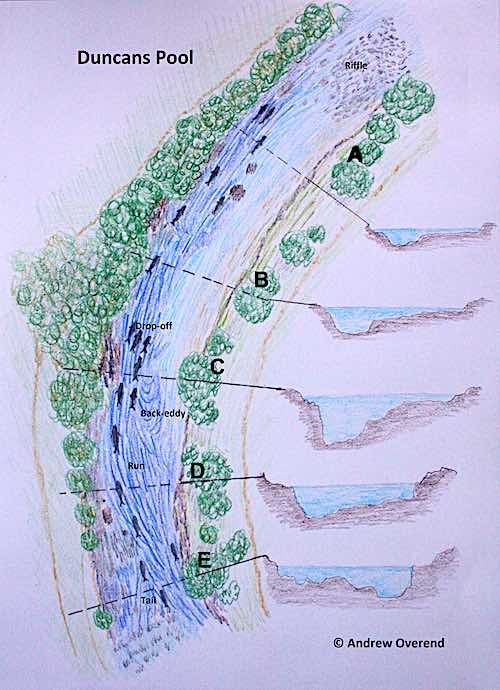
The river quickly flows over large pebbles and boulders between points A and C. Here, both trout and grayling lie close to the far bank in the main channel, as shown on the sketch.
Opposite the 2nd rock outcrop (point C), the river deepens on the far bank to several feet. This drop-off zone and the far-side of the back-eddy hold another concentration of fish.
For the remainder of the pool, the fish hold in the main channel that runs alongside a bedrock ledge near the far bank. Feeding in the foam lanes that have formed.
Opposite point E, the bedrock ledge juts out from the far bank into the middle of the river. Often trout and grayling will lie below this rock outcrop and thus is a great area to fish.
Fishing Duncan’s Pool – low river levels.
For the Welsh Dee, I consider river levels below 0.6 m at Corwen gauge as low water fishing conditions. Under such conditions, good results can be obtained fishing using dry flies, wet flies, or nymphs.
When it’s dull and overcast trout and grayling can be caught in Duncan’s all day long. However, on bright sunny from May to September, the best fishing is before midday or after 6 pm because between mid-day and 6 pm the fish take cover from the glaring sun.
Dry fly fishing
On mild days, dry fly fishing can be great at the start of the trout season (3rd of March) because hungry over-wintered trout eagerly take flies as they emerge. With the best sport occurring around mid-day.
There’s a dramatic improvement in dry fly fishing as the season progresses because the weather warms, and fly hatches become prolific.
By summer trout have become fussy and the best fishing is at daybreak or late into the evening. Also, they tend to concentrate into the fast oxygenated sections of the pool…
- below the riffle,
- around the drop-off section by the 2nd rock outcrop,
- in the tail during summer evenings.
Dry fly fishing improves again during autumn, especially when grayling start to feed in earnest.
Before starting to fish with the dry fly…
It pays to spend a little time watching the pool for signs of fish taking flies at the surface and trying to identify what flies are being taken.
Then starting at the tail of the pool, slowly fish upriver by targeting rising fish and fishing hot spots marked on the sketch of Duncan’s Pool.
Wet fly fishing
If flies are likely to hatch later in the day, it’s best to start fishing Duncan’s Pool with a team of wet flies and/or North Country Spiders.
Fly selection depends on what flies are likely to be hatching at that time of year, and visit the aforementioned links contains more on flies.
If I’m unsure of what flies to fish I often start with a team of three flies spaced 3ft apart in a 3 lb copolymer leader
- point fly – #14 black hopper wet fly
- middle dropper – #14 pearly butt Waterhen Bloa
- top dropper – #14 pearl ribbed March Brown Spider.
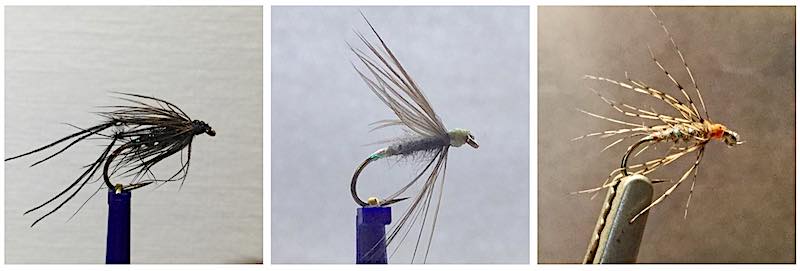
Fishing the tail and top sections of the pool with wet flies can produce good results.
In the top sections of the pool (A to C), it’s best to fish wet flies upstream, but fishing them across and downstream is also effective.
Thoroughly fish breaks in the current because they are often good fish-holding spots.
Bankside obstructions at the tail of the pool make it difficult to fish wet flies upstream. Therefore, fishing across and down from point D to E is the best way to catch trout and grayling there.
If fishing wet flies for 15 minutes hasn’t produced any takes, I switch my approach to short line nymphing.
Euro /Czech nymphing
I find Euro / Czech nymphing the most productive fly fishing method for Duncan’s Pool, but it’s not everyone’s cup of tea.
It’s possible to fish the pool from points A to D by short-line nymphing. However, submerged slippy bedrock in the tail section (D to E) prohibits fishing this section by wading.
Trout and grayling are not evenly distributed throughout the pool and the hot spots for nymphing include…
- behind the submerged boulders from A to B,
- the drop-off at point C,
- gravel run to just past point D.
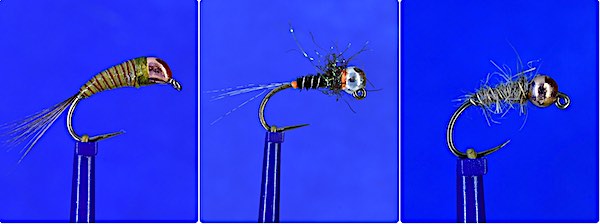
Fly selection:
My fly selection depends on the time of year rather than the pool I’m fishing, and thus is difficult to cover in this article. However, the links below cover the trout and grayling flies I use each month on the Welsh Dee.
- 10 grayling flies for January
- Best grayling flies for February
- 10 Trout flies for March
- 6 April flies for catching more trout
- 11 top trout fly patterns for May
- 8 Great flies for June on the Welsh Dee
- 8 flies for July on the Welsh Dee
- Best trout flies for August
- 12 great flies for September
- 10 grayling flies for October
- Best grayling flies for November
- 13 grayling flies for December
Fishing Duncan's Pool - high river levels
For Duncan’s Pool, I define river levels from 0.6 to 0.9 m (Corwen gauge) as high water fishing conditions, with the pool becoming unfishable above 1 m.
As the river level rises, trout and grayling move from their low-water lies to shelter from the strong current.
In high water, it’s possible to fish with dry flies when trout and grayling are rising. However, wet fly fish and nymphing are much better approaches, especially when the water is coloured.
When the river level is above 0.7 m, I find short-line nymphing between points C and D produces the best results.
Trout and grayling fishing summary
May to Sept
My approach is governed by the time of day and cloud cover.
Early morning wet flies, spiders & nymphing techniques work well followed by dry flies.
On bright sunny days, by mid-day onwards focus on searching the bottom of well-oxygenated, shady runs with Czech nymphs.
In the evening dry flies and wet flies fished close to the surface usually pay dividends.
Oct to April
My approach largely depends on water/air temperature.
On cold days, Czech nymphs work well, particularly when there is little or no fly activity on the surface.
When flies are hatching dry fishing often yields good results.
However, I find wet flies, spiders, and nymphs fished usually out fish dries.
Salmon Fishing Duncan’s Pool
Duncan’s is a good salmon holding pool on the middle beat because the main flow runs through a deep channel alongside a submerged rock platform that offers shelter to resting fish.
It’s also easy to access and fly fish, making it a popular pool. As such, it produces a salmon or two most years.
The sketch of the pool shows its key features and where salmon typically lie when the river level is at 0.7 m and below (Corwen gauge).

Fishing from March to May:
When it’s cold at the start of the salmon season, it’s best to fish a sinking line slowly through the deep sections of the pool. Starting above the drop-off zone (point B) and fishing down to point D.
salmon will be lying in the deep-sheltered sections.
I’ve caught 2 well-mended kelts but not managed to catch a springer fishing Duncan’s pool early in the season. One was caught on a size 12 Silver Butcher in the tail of Duncan’s Pool while fishing for trout from the right bank.
The second kelt was caught below the 2nd rock outcrop while fishing a sinking line and a black and yellow 1” copper tube from the left bank.
When the weather warms at the start of May, I also fish the faster sections of the pool using a floating line tipped with a sinking polyleader.
What are the best fly patterns to use?
This is a good question and one I have struggled with for many years on the Welsh Dee.
There is likely to be an answer, but I need to be catching 20+ salmon per year to arrive at a statistically significant one (that’s the scientist speaking).
Therefore, I use a simple strategy for the selection of which fly use…
#10 - 6 brightly coloured fly
(e.g. Cascade, Park shrimp etc.)
#10 - 16 drab coloured fly
(e.g. Stoats tail, Blue Charm, etc)
“Where are the salmon likely to be lying?”
It’s best to focus on locating where the salmon are lying and how best to cover them such that they take you’re offering. Rather than spending time agonizing over which fly to use on the Welsh Dee.
The majority of salmon I have caught on the Welsh Dee has been on the first run through the pool. Therefore, I now fish quickly through each pool and aim to cover as much of the river as possible.
A side benefit of this strategy is that it keeps you fit.
Salmon fishing June to August:
In recent years on the Welsh Dee, there have been good runs of fish between June and July, probably late spring fish intent on quickly pushing upriver.
After a small spate when the river has been at its summer level, I focus on fishing the neck of the pools because salmon have to spend a little time navigating their way up into the next pool.
The riffle at the head of Duncan’s Pool is one such place where I will slowly work my way through the drop-off zone.
The tail is another place I tend to focus on in the mornings, especially the holes behind the two large submerged boulders.
I now prefer flies dressed on single hooks from size 6 down to 10, fished on a 10ft reservoir trout rod during the summer months.
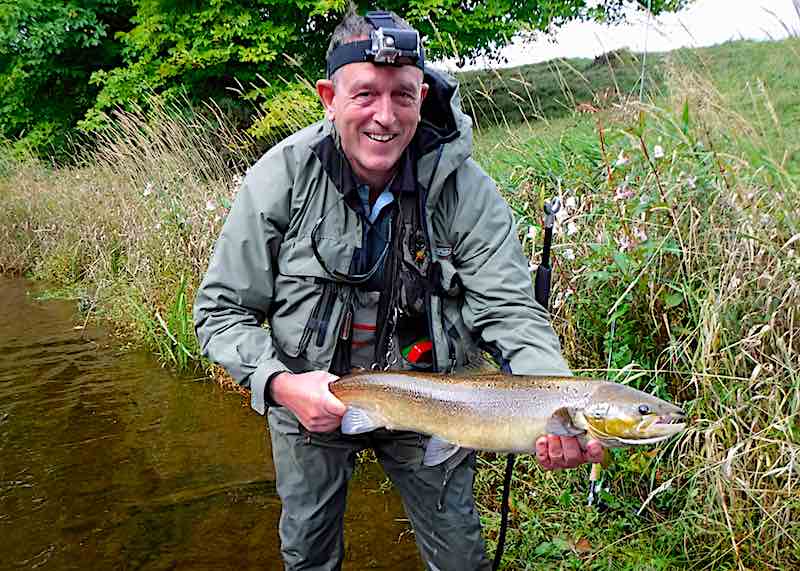
Salmon fishing September to October:
More often than not, I fish a floating line tipped with a tapered sinking leader when salmon fishing in Autumn on the Welsh Dee, especially on bright days.
Below is a short video of a salmon I caught in September fishing Duncan’s Pool. Fishing a #1o red copper-bodied Stoat’s tail on a floating line tipped with a sinking polyleader.
Below is a summary of how to fish Duncan’s Pool with the fly at different river height…
0.7m or less (Manley Hall gauge)
Focus your attention around the rock outcrops close to the shady right bank where the flow starts to slacken a little.
Particularly the drop-off zone by the 2nd rock outcrop where the flow starts to slacken.
On bright sunny days, early morning and evenings offer the best chance.
During the summer months when the river is 0.5m or less, your best chances are “first light” and “last light” in the well-oxygenated areas.
Above 0.7m (Manley Hall gauge)
Fish are either pushed back into the slacker sections closer to the right bank or to the bottom of the deep sections.
Focus your attention on where the submerged features (rocks or ledges) provide shelter from the main flow (see pool sketch).
Don’t forget to fish the tail because there are many submerged features that provide a sanctuary in high water.
The zone downstream of the 2nd rock outcrop is worth a try.
Fishing Duncan's Pool for sea trout
Duncan’s Pool is one of the places on the Dee that I tend to catch at least one sea trout each year. July and August are the best months to catch fish from dusk onwards.
Big sea trout are often heard jumping as it gets dark on warm evenings. I usually catch sea trout in this pool while fishing it from the left bank. Takes occur from the back eddy to the end of the tail of the pool.
When the river is at its summer level, I also fish the tail from the right back on the rock ledge opposite the last tree.
However, you have to be VERY CAREFUL because the ledge is very slippy – I have taken a ducking here a couple of times while trying to get back to the bank.
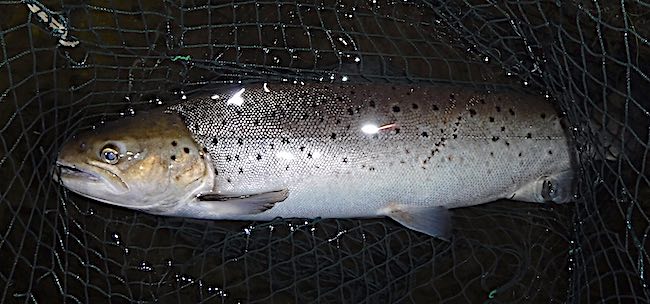
Sea trout start to enter the lower reaches of the Welsh Dee in June. These early sea trout tend to be large and are notoriously difficult to catch. I’m still trying to hook one of these beasts that can be close to double figures in size.
The main run of Welsh Dee sea trout (1 to 3lb mark) arrives at Llangollen in July and peaks in August.
When the river is at its summer level (<0.55m Corwen gauge), the best approach is to start fishing in the riffle as the light starts to fail.
I begin by fishing a team of wet flies (size 14 to 12) on a 3lb tapered copolymer leader e.g. Butcher, Black Hopper, March Brown Spider, Teal Blue & Silver, Black Pennell, or Mallard & Claret.
Normally I cast the flies squarely across the river and try to get them under any overhanging trees on the far bank. Then allow them to swing around in the current. If the current slows on fishing downriver, it helps to flick the rod-tip sideways to add motion to the flies. Often a sea trout will take the fly immediately after the flick.
I increase the breaking strain of the tapered leader to 8 – 10 lbs when it becomes dark and tie on a larger fly (size 10 to 8 singles). Using this new set-up, I fish the remainder of the pool.
If the above approach doesn’t produce any takes, I switch to either a larger subsurface fly or a surface lure…
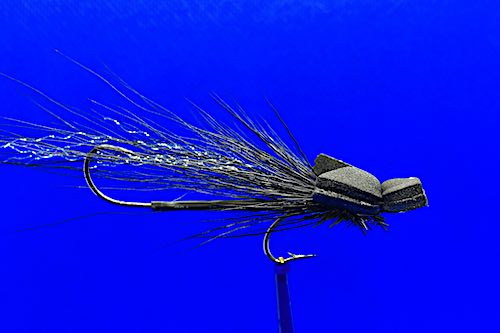
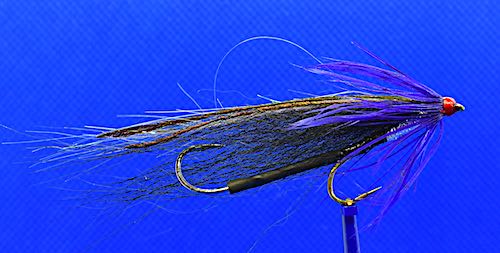
For more on sea trout fishing these post will be of interest
I hope you find the above information useful and it helps to improve your fishing. Even after many years, I’m still trying to improve my fishing. Therefore, it would be great if you can share your experiences.
Where do I get day tickets?
The Duncans Pool is part of Llangollen-Maelor Middle beat and day tickets for visiting anglers can be obtained online.
If further information is required, please click here to contact the club, who will be more than happy to help you.
How to find Duncan’s Pool
From Llangollen, take the A5 to Crown and turn right onto the B5103 after Berwyn Station. Then, turn left at the T-junction and park in the River Dee car Park.
Take the footpath to Llantysilio Parish Church at the Church car park follow the signs marking the way for anglers to access the river. Walk down the path to the river and then walk upriver and over the style into the next field. Duncan’s Pool is located about a further 300 m upriver.
[Disclaimer: like most outdoor sports, fishing is not without its hazards. Therefore, you MUST do your own RISK ASSESSMENT before starting to fish Duncan’s Pool. Especially if you decide to wade and/or fish at night. In addition, you must follow the club rules when fishing this water.]